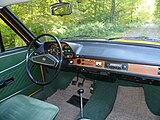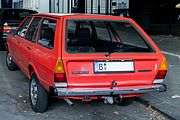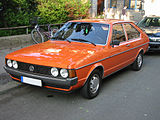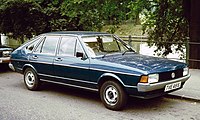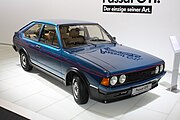VW Passat B1
| Volkswagen | |
|---|---|
|
VW Passat two-door (1973–1975)
|
|
| Passat B1 (32/33) | |
| Production period: | 1973-1980 |
| Class : | Middle class |
| Body versions : | Sedan , hatchback , station wagon |
| Engines: |
Otto engines : 1.3-1.6 liter (40-81 kW) diesel engine : 1.5 liters (37 kW) |
| Length: | 4200 mm |
| Width: | 1620 mm |
| Height: | 1360 mm |
| Wheelbase : | 2470 mm |
| Empty weight : | 880-995 kg |
| Previous model | Type 3 and Type 4 |
| successor | VW Passat B2 |
The Volkswagen Passat B1 is the first generation of the VW Passat , a mid-range model, built from spring 1973 to autumn 1980 . It was largely identical in construction to the Audi 80 B1 introduced in autumn 1972, although it was only available with a notchback . The Passat has a hatchback and was also available as a station wagon.
Production of the Passat began in May 1973. Initially, the model was produced in the main plant in Wolfsburg . In the USA the car was offered under the name Volkswagen Dasher from 1974 , while the station wagon was also sold as the Audi Fox . The Passat was manufactured in Wolfsburg until the end of 1977, and in Emden since August 1977. At the end of the year, production in Clayton, Victoria, Australia (construction period 1974–1977) ran out. In October 1980 the series was replaced by the successor Passat B2 . In Brazil it remained in production parallel to the B2 until December 1988.
Model history
General
The first generation of the Passat (internal designation Type 32 ) was derived from the Audi 80 B1 . The Italian designer Giugiaro gave the first Passat an independent appearance. The new car was immediately well received by the public.
The Basic and L equipment options were on offer at prices starting at DM 9,060, each with a 55 PS (40 kW) 1.3 or a 75 PS (55 kW) 1.5-liter engine ( S and LS ) could be combined. In addition, the top model was the Passat TS with 75 PS (55 kW) or 85 PS (63 kW). In August 1975, the 1.5-liter engines were replaced by 1.6-liter four-cylinder of the same power.
The individual equipment levels were externally recognizable mainly by the different headlights. In the basic configuration, the Passat was equipped with individual round headlights, as L and LS with angular broadband headlights and as TS with double headlights. In the interior of the TS there was a three-spoke sports steering wheel and a center console with three additional instruments.
In January 1974, a station wagon version ( Type 33 ) was presented with the Variant . In addition, the hatchback limousine was available from the start as a two- and four-door model with a small trunk lid, which was also available with a large tailgate from January 1975.
technology

The Passat differed from the Audi 80 by a modified rear section and a rear axle specially redesigned for the Passat. Instead of spring-damper units , springs and dampers were arranged separately so that the trunk was not restricted by strut domes, because the VW was also to be offered as a variant ( station wagon ). The Passat had a four-cylinder engine installed lengthways at the front. The EA827 was derived from the Audi medium-pressure engine (cylinder spacing and position of the shafts were the same), but all essential parts were further developed. The camshaft was now in the cylinder head and was driven with a toothed belt . VW took over the engine unchanged from the Audi 80 introduced in summer 1972.
The Passat's front suspension consisted of MacPherson struts with wishbones and sat with the engine on a subframe. The rack and pinion steering was attached in front of the bulkhead . A torsion crank axle was installed at the rear . Because this requires a lot of space under the rear seats, the tank (made of plastic for the sedan from summer 1976 and the variant since production began) and the spare wheel well were housed behind the axle under the trunk floor. The foot brake operated hydraulic disc brakes at the front and drum brakes at the rear; the handbrake acted on the rear drums via cables.
Facelift
During the production period of the B1, numerous technical innovations were incorporated into the current series:
1975
In January 1975 all models received plastic corners on the bumpers and the upper corners of the windshield were rounded. For the sedans, the large tailgate that reached up to the roof was now also available for an extra charge. The ventilation grilles in the C-pillar of the two-door car were no longer available at the beginning of the model year in August 1974.
In April, further small model maintenance measures were carried out, including foam seats replacing the previous spring core seats.
The last Passat produced at the Salzgitter plant rolled off the production line in June / July .
VW Dasher (US version) with sealed beam headlights
1976
From August onwards, the sporty TS equipment was replaced by the comfort-oriented GL model, which, like the TS before, was externally characterized by double headlights. The angular headlights of the L model have been replaced by individual round headlights as in the basic model, but with chrome rings here.
1977
A major facelift was carried out in August. At the same time, production began at the Volkswagen plant in Emden .
Mainly the front section, the rear and the dashboard were changed. The bonnet and fenders were bevelled towards the grill and the aerodynamic drag coefficient of the body was slightly reduced. Plastic bumpers made the revised car look more modern. Changes to the exhaust system also made the rear silencer disappear better under the body. In contrast to this, the right-hand drive vehicles kept the old instrument panel until the end of production in October 1980.
The last Passat was produced at the Wolfsburg plant on December 15.
1978
From July 1978, the Passat was with the 1.5-liter diesel engine with 50 hp from the Golf I available. It was built in lengthways.
1979
In February 1979, Volkswagen finally presented the Passat GLI with the engine from the Golf GTI . The new engine, in contrast to the injection engine in the previous VW Type 3 model, now equipped with a purely mechanical injection system of the K-Jetronic type from Bosch , provided an output of 81 kW (110 hp) with an empty weight of well under 900 kg for considerable performance . The hatchback models of the GLI had, among other things, a plastic spoiler lip at the rear as a distinguishing feature. Originally it was even planned to sell this variant as a Passat GTI , which, however, the then CEO Toni Schmücker did not classify as sensible in terms of market policy. The prototype had already been made in December 1976, but until then it had only been shown at trade fairs.
1980
On April 14, 1980, the 2,000,000 VW Passat B1 rolled off the assembly line in Emden. Production of the first-generation Passat ends in autumn 1980. The distribution of buyers among the various models is interesting: half of them buy the sedan with the small trunk lid, a quarter each vote for the variant and the sedan with the large lid.
The Passat in Brazil
From June 1974 to December 1988, the Passat B1 was also manufactured in Brazil, initially with the 1.5-liter engine throttled to 48 kW / 65 hp and as a two- and four-door sedan without a large tailgate. The Passat TS followed in 1976 with a 1.6-liter output of 59 kW / 80 hp. From 1978 the Brazilian Passat carried the front section of the Audi 80 B1 with rectangular headlights, and the three-door version with a tailgate was now also available as the Passat LS / LSE.
A large contingent of Brazilian production was delivered to Iraq in 1985 . There the vehicles were still in use as taxis in large numbers until at least 2014. They were not freely available there. Instead, at the behest of Saddam Hussein , they were imported at state expense and given to families who had lost loved ones in the First Gulf War . That is why the Passat is politically charged there and is considered a “ martyr's vehicle ”.
Technical specifications
| VW Passat B1 (1973-1980) | |||||||||||||
|---|---|---|---|---|---|---|---|---|---|---|---|---|---|
| VW Passat: | 1.3 (until 02/1978) |
1.3 (from 02/1978) |
1.5 (until 07/1974) |
1.5 (08 / 1974-07 / 1975) |
1.5 (until 07/1975) |
1.6 (from 08/1975) |
1.6 (from 08/1975) |
GLI (from 02 // 1979) |
1.5 diesel (from 08/1978) |
||||
| Engine: | 4-cylinder in-line engine (four-stroke) | ||||||||||||
| Engine code: | ZA | FY | E.g. | YJ | ZC | YN | YP | YS | CK | ||||
| Displacement: | 1297 cc | 1272 cc | 1471 cc | 1588 cc | 1471 cc | ||||||||
| Bore × stroke: | 75 x 73.4 mm | 75 × 72 mm | 76.5 × 80 mm | 79.5 × 80 mm | 76.5 × 80 mm | ||||||||
| Compression: | 8.5 | 8.2 | 9.7 | 8.2 | 9.7 | 8.2 | 8.2 | 9.5 | 23.5 | ||||
| Performance at 1 / min: |
40 kW (55 PS) 5500 |
40 kW (55 PS) 5800 |
55 kW (75 PS) 5800 |
55 kW (75 PS) 5800 |
63 kW (85 PS) 5800 |
55 kW (75 PS) 5600 |
63 kW (85 PS) 5600 |
81 kW (110 PS) 6100 |
37 kW (50 PS) 5000 |
||||
| Max. Torque at 1 / min: |
94 Nm 2500 |
92 Nm 3500 |
116 Nm 3500 |
114 Nm 3500 |
123 Nm 4000 |
119 Nm 3200 |
124 Nm 3200 |
137 Nm 5000 |
80 Nm 3000 |
||||
| Mixture preparation: | 1 downdraft carburetor Solex 85 PS versions: 1 register downdraft carburetor Solex |
Mechanical injection (Bosch K-Jetronic ) | Diesel distributor pump | ||||||||||
| Valve control: | OHC , timing belt | ||||||||||||
| Cooling: | Water cooling | ||||||||||||
| Transmission: | 4-speed gearbox a.W. for 75/85 hp three-speed automatic |
||||||||||||
| Front suspension: | MacPherson struts , triangular wishbones | ||||||||||||
| Rear suspension: | Torsion crank axle , Panhard rod for lateral guidance, coil springs | ||||||||||||
| Brakes: | Front disc brakes (Ø 239 mm), rear drums (self-adjusting since model year 79), brake booster | ||||||||||||
| Steering: | Rack and pinion steering | ||||||||||||
| Body: | Sheet steel, self-supporting | ||||||||||||
| Track width front / rear: | 1340/1350 mm | ||||||||||||
| Wheelbase: | 2470 mm | ||||||||||||
| Length: | 4190 mm (from 08/77: 4265–4290 mm) | ||||||||||||
| Empty weight: | 880-995 kg | ||||||||||||
| Top speed: | 150 km / h | 150 km / h | 155-160 km / h | 155-160 km / h | 163-168 km / h | 156-160 km / h | 165-173 km / h | 185 km / h | 141 km / h | ||||
| Acceleration from 0-100 km / h: |
16-17 p | 16-17 p | 13.5-16 s | 13.5-16 s | 12-15 s | 13.5-16 s | 12-14.5 s | 10.5-11.5 s | 20.5-21.5 s | ||||
| Consumption in liters / 100 kilometers: |
9-10 N | 9-10 N | 10.5-11.5 S. | 10.5-11.5 N | 10.0-11.0 S | 10.5-11.0 N | 10.5-11.0 N | 10.5 S. | 7.5 D | ||||
swell
- Automobil Revue , catalog numbers 1975, 1977, 1979
- Werner Oswald : Deutsche Autos 1945–1990 , Vol. 3. Motorbuch Verlag, Stuttgart 2. Ed. 2003, ISBN 3-613-02116-1 , pp. 94–101
- Homepage of VW do Brasil
- Volkswagen Aktiengesellschaft: Workshop Manual "The Passat", Type 32/33, May 1973 (incl. Supplements)
Web links
- Official VW profile for the Passat B1
- Homepage of a Passat club for the Passat B1 and B2 with further detailed information
- Report on the Passat GTI (prototype)
Individual evidence
- ^ Works council Volkswagen AG - Salzgitter plant (ed.): Dermotor. Salzgitter 2010, p. 16
- ↑ http://www.wolfsburger-nachrichten.de/wolfsburg/article208986701/15-Dezember-1977-Heute-vor-39-Jahren.html




